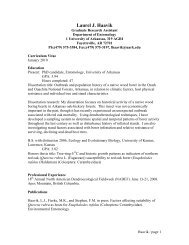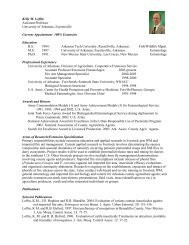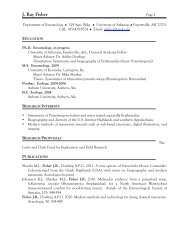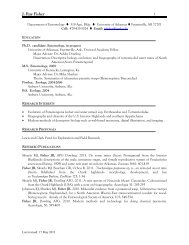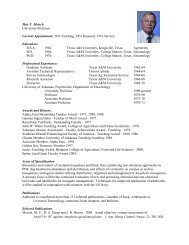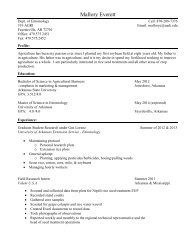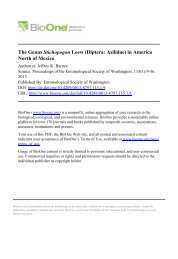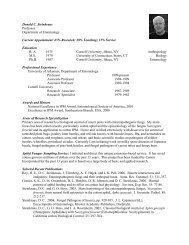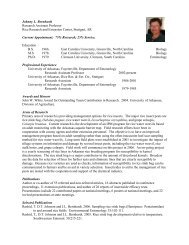Dr. Raghu Sathyamurthy - Department of Entomology - University of ...
Dr. Raghu Sathyamurthy - Department of Entomology - University of ...
Dr. Raghu Sathyamurthy - Department of Entomology - University of ...
Create successful ePaper yourself
Turn your PDF publications into a flip-book with our unique Google optimized e-Paper software.
CURRICULUM VITAE<br />
<strong>Raghu</strong> <strong>Sathyamurthy</strong> (S. <strong>Raghu</strong>)<br />
Personal Information<br />
Current Address:<br />
Work:<br />
Telephone:<br />
Email:<br />
<strong>Department</strong> <strong>of</strong> <strong>Entomology</strong>,<br />
Rice Research & Extension Center<br />
<strong>University</strong> <strong>of</strong> Arkansas<br />
2900 Hwy 130 East<br />
Stuttgart, AR72160, USA<br />
+1-870-673-2661 (W)<br />
+1-870-659-5042 (M)<br />
raghu@uark.edu<br />
Current Position (October 2012 to date)<br />
Associate Pr<strong>of</strong>essor (Insect Ecology; <strong>University</strong> <strong>of</strong> Arkansas), & Adjunct Faculty (Illinois<br />
Natural History Survey, <strong>University</strong> <strong>of</strong> Illinois):<br />
In this role, my primary responsibility is to undertake research on the ecology, evolution<br />
and management <strong>of</strong> invasive insects and weeds in rice-dominated agroecosystems. In<br />
addition I undertake collaborative research on diversity <strong>of</strong> topics aligned with my<br />
research interests.<br />
Current research interests<br />
Invasive Species Management, Autecology, Population Ecology, Plant-Herbivore<br />
Interactions, Insect Ecology and Behaviour, Biological Control, Ecological Risk<br />
Assessment, Sustainable Plant Industries, Environmental Management<br />
Education<br />
2002 Doctor <strong>of</strong> Philosophy, Griffith <strong>University</strong><br />
1998 Master <strong>of</strong> Science in Environmental Management, Griffith <strong>University</strong><br />
1996 Bachelor <strong>of</strong> Science in Zoology, <strong>University</strong> <strong>of</strong> Madras<br />
2004 Graduate Certificate in Environmental Statistics, <strong>University</strong> <strong>of</strong> Canberra<br />
Pr<strong>of</strong>essional & Research Experience<br />
My research strengths are in using theoretical and empirical ecology to facilitate better<br />
natural resource management outcomes. In terms <strong>of</strong> taxa, I have worked on plants<br />
(rainforest dynamics, weed ecology, arid zone ecology, and sustainable primary<br />
production), insects (grasshoppers, fruit flies, beetles, cicadas, scale insects, moths,<br />
bugs and midges) and microorganisms (with respect to insect-plant interactions). I have<br />
also worked on direct anthropogenic impacts on natural resources (fuelwood removal<br />
and its implications, ecological effects <strong>of</strong> human-induced noise). Expertise in these<br />
diverse areas is reflected in my publication pr<strong>of</strong>ile. In addition to a sound research<br />
background in ecology, I also possess strong quantitative skills in biostatistics and<br />
ecological modeling. I have an advanced understanding <strong>of</strong> statistical tools (parametric,<br />
non-parametric statistics and multivariate statistics).<br />
Last revised on: February 11, 2013 Page 1 <strong>of</strong> 14
Teaching & Supervision Experience<br />
Teaching Philosophy: To inspire and educate through engagement in open dialogue and<br />
the use <strong>of</strong> the scientific method, whilst simultaneously acknowledging science as just<br />
one way <strong>of</strong> perceiving the world.<br />
I have taught undergraduate- and graduate-level courses in India, Australia and the U.S.<br />
To date, I have mentored 7 graduate students (4 Ph.D. and 3 M.S.), 2 postdoctoral<br />
fellows, and over a dozen undergraduate students. I currently serve on the PhD<br />
committee <strong>of</strong> 2 graduate students, and am mentoring 1 postdoctoral fellow.<br />
Communication Record (http://www.researcherid.com/rid/A-1281-2010)<br />
Peer-reviewed publications (61)<br />
<strong>Raghu</strong>, S., Nano, C.E.M., and Pavey, C.R. (in press). A demographic framework for<br />
the adaptive management <strong>of</strong> the endangered arid zone tree species, Acacia peuce.<br />
Australian Journal <strong>of</strong> Botany<br />
Osunkoya, O.O., Perrett, C., Fernando, C., Clark, C., and <strong>Raghu</strong>, S. (in press)<br />
Modeling population growth and site specific control <strong>of</strong> the invasive Lantana<br />
camara L. (Verbenaceae). Population Ecology<br />
<strong>Raghu</strong>, S. Purcell, M.F. and Wright, A.D. (2013). Catchment context and the bottomup<br />
regulation <strong>of</strong> the abundance <strong>of</strong> specialist semi-aquatic weevils on water<br />
hyacinth. Ecological <strong>Entomology</strong> 38: 117–122. doi: 10.1111/j.1365-<br />
2311.2012.01400.x<br />
Osunkoya, O.O., Perrett, C., Fernando, C., Clark, C., and <strong>Raghu</strong>, S. (2012) Stand<br />
dynamics and spatial pattern across varying sites in the invasive Lantana camara<br />
L. (Verbenaceae). Plant Ecology 213: 883–897. doi: 10.1007/s11258-012-0050-4<br />
Evans, J.A., Davis, A.S., <strong>Raghu</strong>, S., Ragavendran, A., Landis, D.A. and Schemske,<br />
D.W. (2012). The importance <strong>of</strong> space, time and stochasticity to the demography<br />
and management <strong>of</strong> Alliaria petiolata. Ecological Applications 22: 1497–1511.<br />
doi: 10.1890/11-1291.1<br />
Nano, C.E.M., Bowland, A.E., Nano, T.J., <strong>Raghu</strong>, S. & Pavey, C.R. (2012)<br />
Demographic hurdles to persistence in Acacia peuce (F. Muell.): Effects <strong>of</strong><br />
resources, fire and browsing on a threatened keystone tree species from arid<br />
Australia. Journal <strong>of</strong> Arid Environments 80: 17–26.<br />
doi:10.1016/j.jaridenv.2011.12.009<br />
<strong>Raghu</strong>, S., Brown B., and Purcell, M.F. (2012). Searching for the signal <strong>of</strong> competition<br />
in plant-mediated interactions among coexisting gall insects on broad-leaved<br />
paperbark. Arthropod Plant Interactions 6:83–91. doi: 10.1007/s11829-011-<br />
9162-3.<br />
Ahmad, F. Walter, G.H. and <strong>Raghu</strong>, S. (2012). Comparative performance <strong>of</strong> Tribolium<br />
castaneum (Herbst) (Coleoptera: Tenebrionidae) across populations, resource<br />
types and structural forms <strong>of</strong> those resources. Journal <strong>of</strong> Stored Products<br />
Research 48: 73–80. doi: 10.1016/j.jspr.2011.09.005<br />
Arthington, A.H., Page, T.J., Rose, C.W. and <strong>Raghu</strong>, S. (Editors) (2011). A Place <strong>of</strong><br />
Sandhills: Ecology, hydrogeomorphology and management <strong>of</strong> Queensland’s<br />
Dune Islands. Proceedings <strong>of</strong> the Royal Society <strong>of</strong> Queensland 117: 1–532.<br />
Hidalgo, M., Oliver, G., <strong>Raghu</strong>, S. (2011). Economic and environmental assessment <strong>of</strong><br />
the performance <strong>of</strong> reduced rates <strong>of</strong> two post-emergence herbicides in an arid<br />
irrigated production system <strong>of</strong> central Australia: a pilot study. Plant Protection<br />
Quarterly 26: 49–53<br />
Last revised on: February 11, 2013 Page 2 <strong>of</strong> 14
Ridley, A.W., Hereward, J.P., Daglish, G.J., <strong>Raghu</strong>, S., Collins, P.J. and Walter, G.H.<br />
(2011). The spatiotemporal dynamics <strong>of</strong> Tribolium castaneum (Herbst): adult<br />
flight and gene flow. Molecular Ecology 20: 1635–1646.<br />
Sheppard, A.W., <strong>Raghu</strong>, S., Begley, C. and Richardson, D.M. (2011). Biosecurity in<br />
the new Bioeconomy. Current Opinion in Environmental Sustainability 3: 1–3.<br />
doi: 10.1016/j.cosust.2011.01.003 (Editorial)<br />
<strong>Raghu</strong>, S., Spencer, J.L., Davis, A.S., and Wiedenmann, R.N. (2011). Ecological<br />
considerations in the sustainable development <strong>of</strong> terrestrial bi<strong>of</strong>uel crops. Current<br />
Opinion in Environmental Sustainability 3: 15–23. doi:<br />
10.1016/j.cosust.2010.11.005<br />
Sheppard, A.W., <strong>Raghu</strong>, S., Begley, C., Genovesi, P., De Barro, P., Tasker, A. and<br />
Roberts, B. (2011). Biosecurity as an integral part <strong>of</strong> the new Bioeconomy: a path<br />
to a more sustainable future. Current Opinion in Environmental Sustainability 3:<br />
105–111. doi:10.1016/j.cosust.2010.12.012<br />
Davis, A.S., Cousens, R.D., Hill, J., Mack, R.N., Simberl<strong>of</strong>f, D., and <strong>Raghu</strong>, S. (2010).<br />
Screening bioenergy feedstock crops to mitigate invasion risk. Frontiers in<br />
Ecology and the Environment 8: 533–539. doi:10.1890/090030<br />
Davis, A.S., and <strong>Raghu</strong>, S. (2010). Weighing abiotic and biotic influences on weed<br />
seed predation. Weed Research 50: 402–412.<br />
Ellis, G., Oliver, G., Vincent, A. and <strong>Raghu</strong>, S. (2010). The effect <strong>of</strong> irrigation and<br />
weed competition on yield <strong>of</strong> a commercial-scale bush tomato (Solanum centrale)<br />
production system in arid Central Australia. DKCRC Working Paper 74, Desert<br />
Knowledge CRC, Alice Springs (ISBN: 978 1 74158 168 0; ISSN 1833-7309)<br />
Spencer, J.L. and <strong>Raghu</strong>, S. (2009). Refuge or reservoir? The potential impacts <strong>of</strong> the<br />
bi<strong>of</strong>uel crop Miscanthus x giganteus on a major pest <strong>of</strong> maize. PLoS ONE 4(12):<br />
e8336. doi:10.1371/journal.pone.0008336<br />
Prentis, P. Sigg, D., <strong>Raghu</strong>, S., Dhileepan, K. and Lowe, A. (2009). Worldwide<br />
phylogeography <strong>of</strong> two globally invasive plants reveals contrasting introduction<br />
histories and genetic dynamics. Diversity and Distributions 15: 822–830.<br />
Morin, L., Reid, A.M., Sims, N.M., Buckley, Y.M., Dhileepan, K., Hastwell, G.T.,<br />
Nordblom, T.L. and <strong>Raghu</strong>, S. (2009). Review <strong>of</strong> approaches to evaluate the<br />
effectiveness <strong>of</strong> weed biological control agents. Biological Control 51: 1–15.<br />
<strong>Raghu</strong>, S. and Post, S.L. (2008). Cold stratification requirements for germination <strong>of</strong><br />
Alliaria petiolata. Invasive Plant Science and Management 1: 315–318.<br />
Bartelt, R.J., Cossé, A.A., Zilkowski, B.W., Wiedenmann, R.N. and <strong>Raghu</strong>, S. (2008).<br />
Mid-summer pheromone biology <strong>of</strong> Galerucella calmariensis and observations<br />
regarding dispersal and colonization. Biological Control 46: 409–416.<br />
Prentis, P., <strong>Raghu</strong>, S., Dhileepan, K. and Lowe, A. (2008). Worldwide phylogeography<br />
<strong>of</strong> the globally invasive plant: Jatropha gossypiifolia. In: van Klinken, R.D.,<br />
Osten, V.A., Panetta, F.D. and Scanlan, J.C. Proceedings <strong>of</strong> the 16 th Australian<br />
Weeds Conference, pp. 150-152, Queensland Weeds Society, Brisbane, May 18-<br />
22, 2008 (peer-reviewed conference paper and presentation).<br />
Danderson, C.A., Molano-Flores, B. and <strong>Raghu</strong>, S. (2008). Impact <strong>of</strong> floral herbivory<br />
by Coleotechnites eryngiella Bottimer (Lepidoptera: Gelechiidae) on the<br />
reproductive output <strong>of</strong> Eryngium yuccifolium Michaux (Apiaceae): a test <strong>of</strong> the<br />
reserve ovary model. Plant Ecology 197: 277–284.<br />
Popple, L. Walter, G.H. and <strong>Raghu</strong>, S. (2008). The structure <strong>of</strong> calling songs in the<br />
cicada taxon Pauropsalta annulata Goding and Froggatt (Hemiptera: Cicadidae)<br />
– Evidence <strong>of</strong> diverging populations? Evolutionary Ecology 22: 203–215.<br />
Last revised on: February 11, 2013 Page 3 <strong>of</strong> 14
<strong>Dr</strong>ew, R.A.I., <strong>Raghu</strong>, S. and Halcoop, P. (2008). Briding the morphological and<br />
biological species concepts – studies on the Bactrocera dorsalis (Hendel)<br />
complex (Diptera: Tephritidae: Dacinae) in South East Asia. Biological Journal<br />
<strong>of</strong> the Linnean Society 93: 217–226.<br />
<strong>Raghu</strong>, S., Dhileepan, K. and Scanlan, J.C. (2007). Predicting risk and benefit a priori<br />
in biological control <strong>of</strong> invasive plant species: a systems modelling approach.<br />
Ecological Modelling 208: 247–262.<br />
<strong>Raghu</strong>, S. and Walton, C. (2007). Understanding the ghost <strong>of</strong> Cactoblastis past:<br />
historical clarifications on a poster-child <strong>of</strong> classical biological control.<br />
BioScience 57: 699–705.<br />
Dorji, C., Clarke, A.R., <strong>Dr</strong>ew, R.A.I., Fletcher, B.S., Loday, P., Mahat, K., <strong>Raghu</strong>, S.<br />
& Romig, M.C. (2006). Seasonal phenology <strong>of</strong> Bactrocera minax (Diptera:<br />
Tephritidae) in western Bhutan. Bulletin <strong>of</strong> Entomological Research 96: 531–<br />
538.<br />
<strong>Raghu</strong>, S., Anderson, R.C., Daehler, C.C., Davis, A.S., Wiedenmann, R.N.,<br />
Simberl<strong>of</strong>f, D. and Mack, R.N. (2006). Adding bi<strong>of</strong>uels to the invasive species<br />
fire? Science 313: 1742. (Policy Forum)<br />
Schwab, L.K. and <strong>Raghu</strong>, S. (2006). Nutrient composition <strong>of</strong> soil and plant may<br />
predict the distribution and abundance <strong>of</strong> specialist insect herbivores: implications<br />
for agent selection in weed biological control. Australian Journal <strong>of</strong> <strong>Entomology</strong><br />
45: 345–348.<br />
<strong>Raghu</strong>, S., Dhileepan, K. and Wilson, J. (2006). Refining the process <strong>of</strong> agent selection<br />
through understanding plant demography and plant response to herbivory.<br />
Australian Journal <strong>of</strong> <strong>Entomology</strong> 45: 308–316.<br />
Dhileepan, K., Senaratne, K.A.D.W. and <strong>Raghu</strong>, S. (2006). A systematic approach to<br />
biological control agent exploration and prioritisation for prickly acacia (Acacia<br />
nilotica ssp. indica). Australian Journal <strong>of</strong> <strong>Entomology</strong> 45: 303–307.<br />
<strong>Raghu</strong>, S. and van Klinken, R.D. (2006). Refining the ecological basis for agent<br />
selection in weed biological control. Australian Journal <strong>of</strong> <strong>Entomology</strong> 45: 251–<br />
252. (Editorial)<br />
van Klinken, R.D. and <strong>Raghu</strong>, S. (2006). A scientific approach to agent selection.<br />
Australian Journal <strong>of</strong> <strong>Entomology</strong> 45: 253–258.<br />
Dhileepan, K., Treviño, M. and <strong>Raghu</strong>, S. (2006). Temporal patterns in incidence and<br />
abundance <strong>of</strong> Aconophora compressa (Hemiptera: Membracidae), a biological<br />
control agent for Lantana camara, on target and nontarget plants. Environmental<br />
<strong>Entomology</strong> 35: 1001–1012.<br />
<strong>Raghu</strong>, S., Dhileepan, K. and Treviño, M. (2006). Response <strong>of</strong> an invasive liana to<br />
simulated herbivory: Implications for its biological control. Acta Oecologica 29:<br />
335–345.<br />
Dhileepan, K., Cr<strong>of</strong>t, B.J., Ridley, A., James, A.P. and <strong>Raghu</strong>, S. (2006) Susceptibility<br />
<strong>of</strong> source plants to Sugarcane Fiji disease virus influences the acquisition and<br />
transmission <strong>of</strong> the virus by the planthopper vector Perkinsiella saccharicida.<br />
Journal <strong>of</strong> Applied <strong>Entomology</strong> 130: 67–71.<br />
Dhileepan, K., Treviño, M. and <strong>Raghu</strong>, S. (2005). Effect <strong>of</strong> temperature on the survival<br />
<strong>of</strong> Aconophora compressa (Hemiptera: Membracidae): Implications for weed<br />
biocontrol. Australian Journal <strong>of</strong> <strong>Entomology</strong> 44: 457–462.<br />
Sheppard, A. and <strong>Raghu</strong>, S. (2005). Working at the interface <strong>of</strong> art and science: How<br />
best to select an agent for classical biological control? Biological Control 34:<br />
233–235. (Editorial)<br />
Last revised on: February 11, 2013 Page 4 <strong>of</strong> 14
<strong>Raghu</strong>, S. and Dhileepan, K. (2005). The value <strong>of</strong> simulating herbivory in selecting<br />
effective weed biological control agents. Biological Control 34: 265–273.<br />
<strong>Raghu</strong>, S., Wiltshire, C. and Dhileepan, K. (2005). Pre-dispersal seed predation in the<br />
invasive legume Leucaena leucocephala is limited by duration <strong>of</strong> pod retention.<br />
Austral Ecology 30: 310–318.<br />
Balagawi, S., Vijaysegaran, S., <strong>Dr</strong>ew, R.A.I. and <strong>Raghu</strong>, S. (2005). The influence <strong>of</strong><br />
fruit traits on oviposition preference and <strong>of</strong>fspring performance <strong>of</strong> Bactrocera<br />
tryoni (Froggatt), on three tomato (Lycopersicon lycopersicum) varieties.<br />
Australian Journal <strong>of</strong> <strong>Entomology</strong> 44: 97–103.<br />
Dhileepan, K., Treviño, M., Donnelly, G. and <strong>Raghu</strong>, S. (2005). Risk to non-target<br />
plants from Charidotis auroguttata (Chrysomelidae: Coleoptera), a potential<br />
biocontrol agent for Cat’s Claw Creeper Macfadyena unguis-cati (Bignoniaceae)<br />
in Australia. Biological Control 32: 450–460.<br />
Clarke, A.R., Armstrong, K.F., Carmichael, A.E., Milne, J.R., <strong>Raghu</strong>, S., Roderick,<br />
G.R. and Yeates, D.K. (2005). Invasive phytophagous pests arising through a<br />
recent tropical evolutionary radiation: The Bactrocera dorsalis complex <strong>of</strong> fruit<br />
flies. Annual Review <strong>of</strong> <strong>Entomology</strong> 50: 293–319.<br />
<strong>Raghu</strong>, S. (2004) Functional significance <strong>of</strong> phytochemical lures to dacine fruit flies<br />
(Diptera: Tephritidae): an ecological and evolutionary synthesis. Bulletin <strong>of</strong><br />
Entomological Research 94: 385–399.<br />
<strong>Raghu</strong>, S., <strong>Dr</strong>ew, R.A.I. and Clarke, A.R. (2004) Influence <strong>of</strong> microclimate and<br />
structural attributes <strong>of</strong> the host plant on the abundance and behaviour <strong>of</strong> a<br />
tephritid fly. Journal <strong>of</strong> Insect Behaviour 17: 179–190.<br />
Putulan, D., Sar, S. <strong>Dr</strong>ew, R.A.I., <strong>Raghu</strong>, S. and Clarke, A.R. (2004) Fruit and<br />
vegetable movement on domestic flights in Papua New Guinea and the risk <strong>of</strong><br />
spreading fruit flies (Diptera: Tephritidae). International Journal <strong>of</strong> Pest<br />
Management 50: 17–22.<br />
<strong>Raghu</strong>, S. and Clarke, A.R. (2003) Spatial and temporal partitioning <strong>of</strong> behaviour by<br />
adult dacines: Direct evidence for methyl eugenol as a mate rendezvous cue for<br />
Bactrocera cacuminata. Physiological <strong>Entomology</strong> 28: 175–184.<br />
<strong>Raghu</strong>, S. and Clarke, A.R. (2003) Sexual selection in a tropical fruit fly: role <strong>of</strong> a<br />
plant derived chemical in mate choice. Entomologia Experimentalis et Applicata<br />
108: 53–59.<br />
<strong>Raghu</strong>, S., Halcoop, P. and <strong>Dr</strong>ew, R.A.I. (2003) Apodeme and ovarian development as<br />
predictors <strong>of</strong> physiological status in Bactrocera cacuminata (Hering) (Diptera:<br />
Tephritidae). Australian Journal <strong>of</strong> <strong>Entomology</strong> 42: 281–286.<br />
<strong>Raghu</strong>, S. and Lawson, A.E. (2003). Feeding behaviour <strong>of</strong> Bactrocera cacuminata<br />
(Hering) on methyl eugenol: a laboratory assay. Australian Journal <strong>of</strong><br />
<strong>Entomology</strong> 42: 149–152.<br />
<strong>Dr</strong>ew, R.A.I. and <strong>Raghu</strong>, S. (2002). The fruit fly fauna (Diptera: Tephritidae: Dacinae)<br />
<strong>of</strong> the rainforest habitat <strong>of</strong> the Western Ghats, India. Raffles Bulletin <strong>of</strong> Zoology<br />
50: 327–352.<br />
<strong>Raghu</strong>, S., Clarke, A.R. and Yuval, B. (2002). Investigation <strong>of</strong> physiological<br />
consequences <strong>of</strong> feeding on methyl eugenol by Bactrocera cacuminata (Diptera:<br />
Tephritidae). Environmental <strong>Entomology</strong> 31: 941–946.<br />
<strong>Raghu</strong>, S., Clarke, A.R. and Bradley, J. (2002). Microbial mediation <strong>of</strong> fruit fly – host<br />
plant interaction. Is the host plant the “centre <strong>of</strong> activity”? Oikos 97: 319–328.<br />
<strong>Raghu</strong>, S. and Clarke, A.R. (2001). Distribution and abundance <strong>of</strong> Bactrocera<br />
bryoniae (Tryon) in three different habitat-types in South-eastern Queensland,<br />
Last revised on: February 11, 2013 Page 5 <strong>of</strong> 14
Australia. International Journal <strong>of</strong> Ecology and Environmental Sciences 27: 179–<br />
183.<br />
<strong>Raghu</strong>, S, Clarke, A.R. <strong>Dr</strong>ew, R. A. I. and Hulsman, K. (2000). Impact <strong>of</strong> habitat<br />
modification on the distribution and abundance <strong>of</strong> fruit flies (Diptera:<br />
Tephritidae) in south-east Queensland. Population Ecology 42: 153–160.<br />
Raman, A., <strong>Raghu</strong>, S. and Sreenath, S. (2000). Integrating environment, education, and<br />
employment for a sustainable society: an HRD agenda for developing countries.<br />
Current Science 78: 101–107.<br />
<strong>Raghu</strong>, S., Hulsman, K. Clarke, A.R. and <strong>Dr</strong>ew, R. A. I. (2000). A rapid method <strong>of</strong><br />
estimating abundant fruit fly species (Diptera: Tephritidae) in modified Steiner<br />
traps. Australian Journal <strong>of</strong> <strong>Entomology</strong> 39: 15–19.<br />
Johny, S. Muthukumaravel, K., <strong>Raghu</strong>, S., Muralirangan, M. C. and Sanjayan, K. P.<br />
(1999). Geographical distribution <strong>of</strong> cephaline gregarines (Apicomplexa:<br />
Protozoa) in relation to grasshoppers (Orthoptera: Acrididae) in Tamil Nadu,<br />
India. International Journal <strong>of</strong> Ecology and Environmental Sciences 25: 201–207.<br />
Brown, A. L. and <strong>Raghu</strong>, S. (1998). An overview <strong>of</strong> research on the effects <strong>of</strong> noise on<br />
animals. Acoustics Australia 26: 63–67.<br />
Publications in review<br />
1. Kaye, L., Walter, G.H., and <strong>Raghu</strong>, S. (in prep.) Constancy in factor space results<br />
in a patchy distribution across hetereogenous environments in the cycad<br />
Macrozamia lucida. Conservation Biology<br />
2. Robson, J., Walter, G.H., and <strong>Raghu</strong>, S. (in prep.) Plant stress and genotype as<br />
predictors <strong>of</strong> distribution and abundance <strong>of</strong> the date palm scale Parlatoria<br />
blanchardii (Targioni) (Hemiptera: Diaspididade) in an arid environment. Journal<br />
<strong>of</strong> Applied <strong>Entomology</strong><br />
3. <strong>Raghu</strong>, S. (in prep.). How susceptible are seedlings <strong>of</strong> the woody invasive Jatropha<br />
gossypiifolia to simulated herbivory? Journal <strong>of</strong> Tropical Ecology<br />
4. <strong>Raghu</strong>, S. and Hughes, L. (in prep.). Relative effects <strong>of</strong> different management<br />
options on the performance <strong>of</strong> the invasive woody vine Macfadyena unguis-cati.<br />
Ecological Management and Restoration<br />
5. <strong>Raghu</strong>, S. and Hughes, L. (in prep.). Relative effects <strong>of</strong> different management<br />
options on nutrient dynamics in the invasive woody vine Macfadyena unguis-cati.<br />
Ecological Management and Restoration<br />
6. <strong>Raghu</strong>, S., Yuval, B. and Clarke, A.R. (in prep.). Sexual maturity and physiological<br />
status <strong>of</strong> Bactrocera cacuminata visiting the larval host plant. Entomologia<br />
Experimentalis et Applicata<br />
Non-refereed & Editorially-reviewed Publications (15)<br />
<strong>Raghu</strong>, S. (2011). Resource Strategies <strong>of</strong> Wild Plants. Joseph M. Craine. Princeton<br />
<strong>University</strong> Press, Princeton, 2009. xvii + 331 pp. Price AUD $49.00, ISBN 978 0<br />
691 13912 8 (paperback). Austral Ecology 36: e15–e16.<br />
<strong>Raghu</strong>, S. and Davis, A.S. (2007). Exotic bi<strong>of</strong>uel grasses – the concerns. Illinois<br />
Steward 16: 30–33.<br />
<strong>Raghu</strong>, S. (2007). Are the opportunities <strong>of</strong> the emerging bioeconomy likely to add to<br />
the burden <strong>of</strong> invasive species management? INHS Reports 391:1, 7.<br />
<strong>Raghu</strong>, S., Post, S.L. and Wiedenmann, R.N. (2006). Invasive exotic plants in Illinois.<br />
Outdoor Illinois XIV(May): 2–5.<br />
<strong>Raghu</strong>, S. and Post, S.L. (2005). Garlic mustard – Understanding the beast. Illinois<br />
Steward 14: 5<br />
Last revised on: February 11, 2013 Page 6 <strong>of</strong> 14
Hastwell, G. and <strong>Raghu</strong>, S. (2005). The Nature <strong>of</strong> Scientific Evidence: Statistical,<br />
Philosophical and Empirical Considerations. M.L. Taper and S.R. Lele (Eds).<br />
The <strong>University</strong> <strong>of</strong> Chicago Press, Chicago. 2004, xviii + 567 pages. Price<br />
AUD$45.00, ISBN 0 226 78957 8 (paperback). Austral Ecology 30: 709–710.<br />
<strong>Raghu</strong>, S. (2005). Insect Pest Management and Ecological Research. G.H. Walter.<br />
Cambridge <strong>University</strong> Press, Cambridge, U.K.2003, i-xii + 387pp. A$200.00.<br />
ISBN 0521800625 (hardback). Australian Journal <strong>of</strong> <strong>Entomology</strong> 44: 209–211.<br />
<strong>Raghu</strong>, S. (2004). The autecology <strong>of</strong> Bactrocera cacuminata (Hering) (Diptera:<br />
Tephritidae: Dacinae): Functional significance <strong>of</strong> resources. Australian Journal <strong>of</strong><br />
<strong>Entomology</strong> 43: 98–99. (Ph.D. Thesis summary).<br />
<strong>Raghu</strong>, S. and Raman, A. (2001). Insect collection in the tropics: There is always more<br />
than one side to a story. Antenna 25(1): 43–47.<br />
<strong>Raghu</strong>, S. (2001). Is ecology a pr<strong>of</strong>ession and is it certifiable? Bulletin <strong>of</strong> the<br />
Ecological Society <strong>of</strong> America 82(1): 102–103.<br />
<strong>Raghu</strong>, S. (2000). Insect collection in the tropics: obsessions, myths and realities.<br />
Antenna 24(3): 135–140.<br />
<strong>Raghu</strong>, S. (2000). Where have all the developing country editions gone? Bulletin <strong>of</strong> the<br />
Ecological Society <strong>of</strong> America 81(1): 106–107.<br />
<strong>Raghu</strong>, S. (2000). Biology and Behaviour <strong>of</strong> Phytophagous Arthropods in<br />
Synthetic Environments. R. Beiderbeck and A. Raman. Special Issue <strong>of</strong> the<br />
International Journal <strong>of</strong> Ecology and Environmental Sciences, Volume 25, Issue<br />
3, International Scientific Publications. 1999. i-vii +72pp (issue pages 213-284).<br />
International Journal <strong>of</strong> Ecology and Environmental Sciences 26: 83–85.<br />
<strong>Raghu</strong>, S. (2000). Evolutionary Ecology across Three Trophic Levels. Goldenrods,<br />
Gallmakers, and Natural Enemies. W.G. Abrahamson and A.E. Weis.<br />
Monographs in Population Biology, Volume 29, Princeton <strong>University</strong> Press,<br />
Princeton, New Jersey. 1997. i-xiii +456pp. Australian Journal <strong>of</strong> <strong>Entomology</strong><br />
39(2): 95–96.<br />
<strong>Raghu</strong>, S. (2000). Ecological <strong>Entomology</strong>. 2nd ed. C. B. Huffaker and A. P.<br />
Gutierrez. John Wiley & Sons, New York. 1999. i-xix +756 pp. Australian<br />
Journal <strong>of</strong> <strong>Entomology</strong> 39(1): 49–50.<br />
<strong>Raghu</strong>, S. (1998). Geographical distribution, seasonal abundance and habitat<br />
preference <strong>of</strong> fruit fly species (Diptera: Tephritidae) in South-east Queensland,<br />
with special reference to Bactrocera tryoni (Froggatt) and Bactrocera<br />
neohumeralis (Hardy). Australian Journal <strong>of</strong> <strong>Entomology</strong> 37: 371 (M.Sc. Thesis<br />
summary).<br />
Conference Presentations/Publications (25)<br />
Osunkoya, O.O., Perrett, C., Fernando, C., Clark, C., and <strong>Raghu</strong>, S. 2011. Stand<br />
dynamics and spatial pattern across varying land uses in the invasive Lantana<br />
camara L. (Verbenaceae). Ecological Society <strong>of</strong> Australia Annual Conference,<br />
Hobart, November 21-25, 2011.<br />
Spencer, J.L and <strong>Raghu</strong>, S. 2011. The rootworm that roared: Miscanthus, maize and<br />
bi<strong>of</strong>uel ecology. Entomological Society <strong>of</strong> America Annual Conference, Reno,<br />
November 13-16, 2011 (an invited presentation to the Plant-Insect Ecosystems<br />
Section Symposium).<br />
Pallipirambil, G.R., Wiedenmann, R.N. and <strong>Raghu</strong>, S. 2011. Modeling the biomass<br />
production <strong>of</strong> the bi<strong>of</strong>uel crop Miscanthus x giganteus to understand and<br />
communicate benefits and risks. Entomological Society <strong>of</strong> America Annual<br />
Conference, Reno, November 13-16, 2011 (poster presentation).<br />
Last revised on: February 11, 2013 Page 7 <strong>of</strong> 14
Nano, C., Pavey, C. and <strong>Raghu</strong>, S. 2010. A demographic framework for the active<br />
adaptive management <strong>of</strong> the endangered arid zone tree species, Acacia peuce.<br />
Ecological Society <strong>of</strong> Australia Annual Conference, Canberra, December 6-10,<br />
2010.<br />
Nano, C., Pavey, C. and <strong>Raghu</strong>, S. 2010. Bottom-up versus top-down limits on<br />
recruitment in the threatened long-lived arid tree, Acacia peuce. Invited Talk for<br />
Symposium: Dissecting Australian diversity: the key to understanding global<br />
biodiversity, Ecological Society <strong>of</strong> Australia Annual Conference, Canberra,<br />
December 6-10, 2010.<br />
Wiedenmann, R.N. Wood, T.N., Spencer, J.L. and <strong>Raghu</strong>, S. 2009. One person’s joy is<br />
another one’s sorrow: concerns about the potential invasiveness <strong>of</strong> bi<strong>of</strong>uel crops.<br />
Invited Talk for session on <strong>Entomology</strong> and Bioenergy, Entomological Society <strong>of</strong><br />
America, Indianapolis, Indiana, December 13-16, 2009.<br />
Wiedenmann, R.N. and <strong>Raghu</strong>, S. 2009. One person’s joy is another one’s sorrow:<br />
concerns about the potential invasiveness <strong>of</strong> bi<strong>of</strong>uel crops. The Sixth International<br />
IPM Symposium, "Transcending Boundaries", Portland, Oregon, March 23-26,<br />
2009.<br />
Spencer, J.L. and <strong>Raghu</strong>, S. 2009. Refuge or reservoir: The potential impact <strong>of</strong> a<br />
biomass crop on corn rootworm ecology. The Sixth International IPM<br />
Symposium, "Transcending Boundaries", Portland, Oregon, March 23-26, 2009.<br />
Spencer, J.L. and <strong>Raghu</strong>, S. 2008. Managing western corn rootworm behavior in<br />
transgenic corn and other crops. Entomological Society <strong>of</strong> America, Reno,<br />
Nevada, November 16-19, 2008.<br />
Schoeman, J., Cherry, H., Steadman, K.J., Buckley, Y., Panetta, F.D. French, K.,<br />
Michael, P. and <strong>Raghu</strong>, S. 2008. Predicting seed persistence <strong>of</strong> two invasive<br />
weeds, boneseed and bitou bush. Tasmanian Weed Society Conference,<br />
Launceston, Australia, October 16-17, 2008.<br />
Evans, J.A., Davis, A.S., Ragavendran, A., <strong>Raghu</strong>, S., Landis, D.A. and Schemske,<br />
D.W. 2008. Density dependence in natural plant populations: The role <strong>of</strong><br />
demographic variance across gradients <strong>of</strong> population density. 93 rd Annual<br />
Meeting <strong>of</strong> the Ecological Society <strong>of</strong> America, Milwaukee, Wisconsin, August 3-<br />
8, 2008.<br />
Kurylo, J., Molano-Flores, B. and <strong>Raghu</strong>, S. 2008. Does Rhamnus cathartica display<br />
flooding tolerance? 93 rd Annual Meeting <strong>of</strong> the Ecological Society <strong>of</strong> America,<br />
Milwaukee, Wisconsin, August 3-8, 2008.<br />
<strong>Raghu</strong>, S. Dhileepan, K. and Scanlan, J. 2008. Understanding the risk and benefit <strong>of</strong><br />
biological control agents for invasive plant species a priori. International<br />
Organization for Biological Control, Sydney, Australia, February 10-13, 2008.<br />
Davis, A.S., Landis, D., Evans, J. and <strong>Raghu</strong>, S. 2007. Functional analysis <strong>of</strong><br />
nonlinearity in garlic mustard demographic parameters. Weed Science Society<br />
<strong>of</strong> America, San Antonio, Texas, USA, February 4-8, 2007 (poster<br />
presentation).<br />
<strong>Raghu</strong>, S. Dhileepan, K. and Scanlan, J. 2006. Predicting risk and benefit <strong>of</strong> biological<br />
control agents for invasive plant species a priori: A systems modelling<br />
approach. Ecological Society <strong>of</strong> America, Memphis, Tennessee, August 6-11,<br />
2006 (poster presentation).<br />
<strong>Raghu</strong>, S. Dhileepan, K. and Scanlan, J. 2006. Predicting risk and benefit <strong>of</strong> biological<br />
control agents for invasive plant species a priori: A systems modelling<br />
approach. Entomological Society <strong>of</strong> America (North Central Branch meeting),<br />
Bloomington, Illinois, March 26-29, 2006.<br />
Last revised on: February 11, 2013 Page 8 <strong>of</strong> 14
Schwab, L.K., Wiedenmann, R., <strong>Raghu</strong>, S. 2006. Correlations between plant nutrients<br />
and insect herbivore community composition: Implications for biological<br />
control <strong>of</strong> leafy spurge, (Euphorbia esula). Entomological Society <strong>of</strong> America<br />
(North Central Branch meeting), Bloomington, Illinois, March 26-29, 2006.<br />
Schwab, L.K., Wiedenmann, R., <strong>Raghu</strong>, S. 2006. Correlations between plant nutrients<br />
and insect herbivore community composition: Implications for biological<br />
control <strong>of</strong> leafy spurge, (Euphorbia esula). Ecology in an Era <strong>of</strong> Globalization:<br />
Challenges and Opportunities for Environmental Scientists in the Americas, an<br />
International Conference <strong>of</strong> the Ecological Society <strong>of</strong> America, Merida,<br />
Mexico, January 8-12, 2006. (poster presentation)<br />
Popple, L., Walter, G.H., <strong>Raghu</strong>, S. 2005. Acoustic behaviour <strong>of</strong> the cicada taxon<br />
Pauropsalta annulata Goding and Froggatt (Hemiptera: Cicadidae):<br />
Intraspecific variation or cryptic species? XX th International Bioacoustics<br />
Congress, Piran, Slovenia, September 15-19, 2005.<br />
<strong>Raghu</strong>, S., Wiltshire, C. and Dhileepan, K. 2004. Plant podding behaviour is a critical<br />
determinant <strong>of</strong> impact <strong>of</strong> seed predation in the invasive legume Leucaena<br />
leucocephala. ESA 2004 Ecological Society <strong>of</strong> Australia Inc. Annual<br />
Conference, <strong>University</strong> <strong>of</strong> Adelaide, Adelaide, Australia, December 7-10, 2004.<br />
<strong>Raghu</strong>, S., Clarke, A.R. and Lawson, A.E. 2002. Sexual selection in a tropical fruit fly:<br />
role <strong>of</strong> a plant derived chemical in mate choice. Fifth International Congress <strong>of</strong><br />
Dipterology, <strong>University</strong> <strong>of</strong> Queensland, Brisbane, Australia, September 29 to<br />
October 4, 2002.<br />
<strong>Raghu</strong>, S., Clarke, A.R., <strong>Dr</strong>ew, R.A.I. and Hulsman, K. 2000. Impact <strong>of</strong> habitat<br />
modification on the distribution and abundance <strong>of</strong> fruit flies in S.E. Queensland.<br />
ESA 2000 Ecological Society <strong>of</strong> Australia Inc. Annual Conference, La Trobe<br />
<strong>University</strong>, Melbourne, Australia, November 29 to December 1, 2000.<br />
<strong>Raghu</strong>, S. 1999. Suburbia as an optimal habitat for pest fruit fly species: implications<br />
for quarantine and pest management. 30 th AGM and Scientific Conference <strong>of</strong><br />
the Australian Entomological Society, Canberra, Australia, September 28 to<br />
October 2, 1999.<br />
Johny, S., <strong>Raghu</strong>, S. Muralirangan, M. C. and Sanjayan, K. P. 1998. Use <strong>of</strong> native<br />
cephaline gregarines in the control <strong>of</strong> grasshopper pest species. National<br />
Conference on Biological and Biotechnological remedies to Environmental<br />
Pollution, Vorhees College, Vellore, India, December 3-5, 1998.<br />
Invited Talks/Seminars (12)<br />
2012 Water; The Choices – Water Law and Policy Conference, Little Rock,<br />
Arkansas. Invasive species and the sustainable management <strong>of</strong> freshwater<br />
resources.<br />
2011 X111 th International Symposium on the Biological Control <strong>of</strong> Weeds, Kona,<br />
Hawaii. Section: Ecological and Evolutionary Processes. Searching for the<br />
signal <strong>of</strong> competition in plant-mediated interactions among coexisting gall<br />
insects on broad-leaved paperbark<br />
2010 58 th Annual meeting <strong>of</strong> the Entomological Society <strong>of</strong> America, San Diego, CA,<br />
USA. Program Symposium: The Disciplinary and Geographical Diversity <strong>of</strong><br />
Classical Biological Control, Picking winners in classical biological control:<br />
Holy Grail or poisoned chalice?<br />
2010 CSIRO <strong>Entomology</strong>, Canberra, Picking winners in biological control: holy<br />
grail or poisoned chalice?<br />
Last revised on: February 11, 2013 Page 9 <strong>of</strong> 14
2009 Symposium on <strong>Entomology</strong> and Bioenergy, Entomological Society <strong>of</strong> America,<br />
Indianapolis, Indiana, One person’s joy is another one’s sorrow: concerns<br />
about the potential invasiveness <strong>of</strong> bi<strong>of</strong>uel crops<br />
2009 Organisation for Economic Co-operation and Development (OECD) Cooperative<br />
Research Programme International Forum & CSIRO Cutting Edge<br />
Science Symposium, Canberra. Refuge or reservoir? The potential for indirect<br />
impacts <strong>of</strong> a bi<strong>of</strong>uel crop on an important staple food crop<br />
2009 Arid Zone Research Institute, Northern Territory Government. Sustainable<br />
Plant Industries in the arid zone: a research, development and extension<br />
framework<br />
2008 <strong>University</strong> <strong>of</strong> Queensland, <strong>Department</strong> <strong>of</strong> Zoology and <strong>Entomology</strong>.<br />
Demography and allelopathy <strong>of</strong> garlic mustard: implications for management<br />
2007 Alan Fletcher Research Station, Queensland <strong>Department</strong> <strong>of</strong> Primary Industries.<br />
Understanding plant demography can help with optimizing weed<br />
biocontrol efforts: the case <strong>of</strong> garlic mustard in the US<br />
2006 Washington <strong>University</strong> (St. Louis), <strong>Department</strong> <strong>of</strong> Biology (Ecology,<br />
Evolutionary & Population Biology). Understanding Risks and Benefits a priori<br />
in weed biological control<br />
2006 <strong>University</strong> <strong>of</strong> Arkansas, <strong>Department</strong> <strong>of</strong> <strong>Entomology</strong>. Understanding Risks <strong>of</strong><br />
Exotic Species Introductions a priori: An example from weed biological control<br />
2006 <strong>University</strong> <strong>of</strong> Illinois (Urbana-Champaign), Program in Ecology and<br />
Evolutionary Biology. Understanding Risks <strong>of</strong> Exotic Species Introductions a<br />
priori: An example from weed biological control<br />
2005 <strong>University</strong> <strong>of</strong> Illinois (Urbana-Champaign), <strong>Department</strong> <strong>of</strong> <strong>Entomology</strong>. Sex,<br />
Flies and a Revelation: Understanding the functional significance <strong>of</strong> phenyl<br />
propanoids to dacine fruit flies<br />
2005 Queensland <strong>Department</strong> <strong>of</strong> natural Resources, Alan Fletcher Research Station.<br />
Charidotis, Macfadyena and Myoporum: Understanding risk and benefit<br />
2003 Queensland <strong>University</strong> <strong>of</strong> Technology, Faculty <strong>of</strong> Science (School <strong>of</strong> Natural<br />
Resource Sciences). Bugs, Bacteria and Buzzwords: Microbial mediation <strong>of</strong><br />
dacine-host plant interactions<br />
Last revised on: February 11, 2013 Page 10 <strong>of</strong> 14
Funding Record<br />
Funding obtained:<br />
Year Source & Project Title Funding<br />
2011-12 Consortium (Sibelco Australia, <strong>University</strong> <strong>of</strong> Queensland, Griffith<br />
<strong>University</strong>, Queensland <strong>University</strong> <strong>of</strong> Technology) – A Place <strong>of</strong><br />
Sandhills: Ecology, Hydrogeomorphology and Management <strong>of</strong><br />
Queensland’s Dune Islands (CI: <strong>Raghu</strong>, S.; Co-CIs: Arthington,<br />
A.H., Page, T.L., Rose, C.W.) *<br />
AUD$30,250<br />
2009 Northern Territory Research & Innovation Board – Pro<strong>of</strong> <strong>of</strong><br />
Concept Grants – Integrated pest management to enhance<br />
development <strong>of</strong> the date-palm industry (CI: <strong>Raghu</strong>, S.; Co-CI:<br />
Walter, G.H.) C<br />
AUD$39,742<br />
2009 Northern Territory Government – R&D Operating Funds I AUD$61,700<br />
2008-2010 CRCNPB – Grain Insect Ecology (CIs: Daglish, G., Walter, G.H.,<br />
Ridley, A., Schipalius, D., Stevens, M., Holloway, J., Burrill, P.,<br />
Collins, P., <strong>Raghu</strong>, S.; Total grant amount $858,714) C<br />
AUD$134,620<br />
2008 Queensland <strong>Department</strong> <strong>of</strong> Primary Industries & Fisheries<br />
(in support <strong>of</strong> a summer student scholarships) *<br />
2008 Institute for Sustainable Resources (QUT) - Long-term Plant<br />
Ecology and Plant-Herbivore Interactions Research and Teaching<br />
at the Samford Ecological Research Facility (SERF) NC<br />
2007-2009 USDA-NRI (Postdoctoral fellowship) – Genetic variation in<br />
allelopathic activity <strong>of</strong> garlic mustard (Alliaria petiolata): its role<br />
in demography and implications for management (Lankau, R.;<br />
mentors, <strong>Raghu</strong>, S. and Davis, A.S.) C<br />
AUD$9,900<br />
AUD$5000<br />
US$124,655<br />
2006 Illinois Natural History Survey – Equipment Grant – Ceptometer I US$2,846<br />
2006 U.S. Army Core <strong>of</strong> Engineers – Mitigation <strong>of</strong> impacts <strong>of</strong> invasive US$20,000<br />
species due to development activities NC<br />
2006-2007 USDA Specific Cooperative Agreement – Investigations on the US$4,500<br />
demography <strong>of</strong> Alliaria petiolata (garlic mustard) NC<br />
2006 Illinois Natural History Survey – Seed Grants I US$1,000<br />
2005-2006 USDA-CSREES Hatch Program – Biological Control <strong>of</strong> Exotic, $10,000<br />
Invasive Weeds in Illinois NC<br />
2005-2006 Illinois Natural History Survey – Equipment Grant – GPS unit I US$1,100<br />
2005-2006 Illinois Natural History Survey – Equipment Grant – Olympus<br />
QColor 3 Digital Camera & Accessories I<br />
2005-2006 U.S. Army Core <strong>of</strong> Engineers – Mitigation <strong>of</strong> impacts <strong>of</strong> invasive<br />
species due to development activities NC<br />
2005-2006 McHenry County Conservation District – Research on garlic<br />
mustard ecology & biological control NC<br />
2005-2006 Cook County Forest Preserve District – Research on garlic<br />
mustard ecology & biological control NC<br />
2005-2006 Lake County Forest Preserve District – Research on garlic mustard<br />
ecology & biological control NC<br />
2004-2005 Queensland <strong>Department</strong> <strong>of</strong> Natural Resources & Mines – Research<br />
grant – Development <strong>of</strong> biocontrol evaluation protocols I<br />
2004-2005 Queensland <strong>Department</strong> <strong>of</strong> Natural Resources & Mines –<br />
Equipment grant (Plant Canopy Analyzer) I<br />
2003-2004 Queensland <strong>Department</strong> <strong>of</strong> Natural Resources & Mines – Student<br />
fellowship I<br />
2003-2004 Cooperative Research Centre for Australian Weed Management<br />
(in support <strong>of</strong> a summer student scholarship) *<br />
2004-2007 Cooperative Research Centre for Australian Weed Management<br />
(in support <strong>of</strong> a PhD scholarship, $10,000/yr) *<br />
US$5,221<br />
US$5,000<br />
US$2,000<br />
US$5,000<br />
US$7,000<br />
AUD$35,000<br />
AUD$17,340<br />
AUD$1,800<br />
AUD$2,600<br />
AUD$25,984<br />
Last revised on: February 11, 2013 Page 11 <strong>of</strong> 14
Year Source & Project Title Funding<br />
2002-2003 Queensland <strong>Department</strong> <strong>of</strong> Natural Resources & Mines – Research AUD$60,610<br />
grant – Seed predation in Leucaena leucocephala I<br />
1999-2002 Australian Government International Postgraduate Research AUD$55,500<br />
Scholarship *<br />
1999-2002 Griffith <strong>University</strong> Postgraduate Research Scholarship * AUD$55,150<br />
2000-2002 Australian School <strong>of</strong> Environmental Studies, Research Higher AUD$3,300<br />
Degree Financial Allocations I<br />
2000 Griffith <strong>University</strong> Postgraduate Students Association Bursary I AUD$150<br />
2000 Ecological Society <strong>of</strong> Australia Research Award C AUD$800<br />
(I = Internal competitive funds; NC = Non-competitive funds; * = Scholarships & Sponsorships; C =<br />
External competitive funds; All funds required a formal proposal and have/ had reporting requirements)<br />
Note: For grants in US$; PI = Principal Investigator. For grants in AUD$; CI = Chief Investigator and<br />
PI=Partner Investigator<br />
Proposals pending:<br />
Year Source & Project Title Funding<br />
2012 Rice Research & Promotion Board – Monitoring the rice pest complex USD$232,206<br />
across the rice growing regions <strong>of</strong> Arkansas to inform integrated pest<br />
management (CI: <strong>Raghu</strong>, S.) P,C<br />
2012 Rice Research & Promotion Board – The role <strong>of</strong> rice insect pests in the USD$149,787<br />
transmission <strong>of</strong> Bacterial Panicle Blight in rice (CI: <strong>Raghu</strong>, S.; Co-CI:<br />
Wameshi, Y.) P,C<br />
2012 Soybean Promotion Board-Rice Research & Promotion Board (joint<br />
proposal) – Understanding movement <strong>of</strong> pest insects between soybean<br />
and rice in Mid-South agroecosystems to inform integrated pest<br />
management (CI: <strong>Raghu</strong>, S.) P,C<br />
USD$225,060<br />
(I = Internal competitive funds; NC = Non-competitive funds; * = Scholarships; C = External<br />
competitive funds; All funds required a formal proposal and have/ had reporting requirements; P =<br />
pending approval [in review])<br />
Note: For grants in US$; PI = Principal Investigator. For grants in AUD$; CI = Chief Investigator and<br />
PI=Partner Investigator<br />
Pr<strong>of</strong>essional Contributions<br />
2011-current Subject Editor (Biological Control – Weeds), Environmental<br />
<strong>Entomology</strong><br />
2005-current Editorial Board member, Biological Control<br />
Manuscripts reviewed (in past 5 years) for<br />
2012. Biological Control (2), Proceedings <strong>of</strong> the Royal Society <strong>of</strong> Queensland (1),<br />
Environmental <strong>Entomology</strong> (6), Biomass & Bioenergy (1), Arthropod-Plant<br />
Interactions (1), Austral Ecology (1), Entomologia Experimentalis et Applicata (1),<br />
CABI (1 book proposal)<br />
2011. Biological Invasions (1), Biological Control (2), Environmental <strong>Entomology</strong> (11),<br />
BioControl (1), Pest Management Science (1), Journal <strong>of</strong> Economic <strong>Entomology</strong> (1),<br />
Invasive Plant Science and Management (1), Proceedings <strong>of</strong> the Royal Society <strong>of</strong><br />
Queensland (10), Proceedings <strong>of</strong> the 13 th International Symposium on Biological<br />
Control <strong>of</strong> Weeds (42 Abstracts; 5 papers)<br />
2010. Current Opinion in Environmental Sustainability (4), Environmental Science &<br />
Technology (1) Ecological Restoration (1), Biological Invasions (1), Environmental<br />
<strong>Entomology</strong> (2), Biological Control (3), Global Change Biology – Bioenergy (1), Pest<br />
Management Science (1), Proceedings <strong>of</strong> the Royal Society <strong>of</strong> Queensland (4)<br />
Last revised on: February 11, 2013 Page 12 <strong>of</strong> 14
2009. Austral Ecology (1), Ecological Modelling (1), Agricultural and Forest <strong>Entomology</strong> (1)<br />
Biological Control (3), BioControl (1), Australian Journal <strong>of</strong> <strong>Entomology</strong> (1), Pakistan<br />
Journal <strong>of</strong> Zoology (1), Oriental Insects (1)<br />
2008. Perspectives in Plant Ecology, Evolution & Systematics (1), Biological Control (4)<br />
Environmental <strong>Entomology</strong> (1), Ecological Applications (1), Phytopathology (1),<br />
BioControl (1), Weed Science (1), Journal <strong>of</strong> Economic <strong>Entomology</strong> (3), Spanish<br />
Journal <strong>of</strong> Agricultural Research (2), International Journal <strong>of</strong> Ecology and<br />
Environmental Sciences (1), Invasive Plant Science and Management (1), Arthropod-<br />
Plant Interactions (1)<br />
[(#) refers to number <strong>of</strong> manuscripts reviewed]<br />
Memberships <strong>of</strong> Pr<strong>of</strong>essional Societies (current)<br />
Ecological Society <strong>of</strong> Australia, Ecological Society <strong>of</strong> America, Entomological Society<br />
<strong>of</strong> America, INTECOL, Royal Society <strong>of</strong> Queensland<br />
Last revised on: February 11, 2013 Page 13 <strong>of</strong> 14
Pr<strong>of</strong>essional References<br />
(1) <strong>Dr</strong>. R. N. Wiedenmann<br />
Head, <strong>Department</strong> <strong>of</strong> <strong>Entomology</strong><br />
319 Agriculture Building<br />
<strong>University</strong> <strong>of</strong> Arkansas<br />
Fayetteville, AR 72701, U.S.A.<br />
Ph: 479-575-2451<br />
Fax: 479-575-2452<br />
Email: rwieden@uark.edu<br />
(3) <strong>Dr</strong>. A. S. Davis<br />
Ecologist, USDA-ARS<br />
Global Change & Photosynthesis Research<br />
Unit<br />
N-319, Turner Hall, <strong>University</strong> <strong>of</strong> Illinois<br />
1102, S. Goodwin Ave<br />
Urbana, IL 61801, U.S.A.<br />
Ph: +217-333-9654<br />
Email: asdavis1@illinois.edu<br />
(5) <strong>Dr</strong>. G. H. Walter<br />
School <strong>of</strong> Integrative Biology<br />
<strong>University</strong> <strong>of</strong> Queensland<br />
St. Lucia, QLD 4072<br />
Australia.<br />
Ph: +61-7-3365-2228<br />
Fax: +61-7-3365-1655<br />
Email: g.walter@mailbox.uq.edu.au<br />
(7) <strong>Dr</strong>. M. R. Berenbaum<br />
Head, <strong>Department</strong> <strong>of</strong> <strong>Entomology</strong><br />
320 Morrill Hall<br />
<strong>University</strong> <strong>of</strong> Illinois (Urbana-Champaign)<br />
505 S. Goodwin Ave<br />
Urbana, IL 61801, U.S.A.<br />
Ph: 217-333-7784<br />
Fax: 217-244-3499<br />
Email : maybe@illinois.edu<br />
(2) Mr. Matthew Purcell<br />
Director, USDA-ARS Australian<br />
Biological Control Laboratory<br />
CSIRO Ecosystem Sciences<br />
Ecosciences Precinct, 41 Boggo Rd.<br />
Brisbane, QLD 4102, Australia<br />
Ph: + 61-7-3833-5740<br />
Fax: + 61-7-3833-5504<br />
Email: matthew.purcell@csiro.au<br />
(4) <strong>Dr</strong>. J. L. Spencer<br />
Illinois Natural History Survey<br />
<strong>University</strong> <strong>of</strong> Illinois<br />
1816, S. Oak St.<br />
Champaign, IL 61820<br />
Ph: +217-264-6851<br />
Fax: +217-265-5110<br />
Email: spencer1@illinois.edu<br />
(6) <strong>Dr</strong>. R. van Klinken<br />
Group Leader – Population Ecology<br />
CSIRO Ecosystem Sciences<br />
Ecosciences Precinct, 41 Boggo Rd.<br />
Brisbane, QLD 4102, Australia<br />
Ph: + 61-7-3833-5737<br />
Fax: + 61-7-3833-5504<br />
Email: rieks.vanklinken@csiro.au<br />
(8) <strong>Dr</strong>. F. Dane Panetta,<br />
Principal Scientist, Biosecurity<br />
Queensland, <strong>Department</strong> <strong>of</strong><br />
Employment, Economic Development<br />
and Innovation, Queensland Government,<br />
Ecosciences Precinct, GPO<br />
Box 46, Brisbane QLD 4001, Australia<br />
Ph: +61-7-3255-4472<br />
Fax: +61-7-3846-6371;<br />
Email: dane.panetta@gmail.com<br />
Last revised on: February 11, 2013 Page 14 <strong>of</strong> 14





